Jérôme Bonaparte
Jérôme-Napoléon Bonaparte (born Girolamo Buonaparte; 15 November 1784 – 24 June 1860) was the youngest brother of Napoleon I and reigned as Jerome Napoleon I (formally Hieronymus Napoleon in German), King of Westphalia, between 1807 and 1813. Historian Owen Connelly points to his financial, military, and administrative successes and concludes he was a loyal, useful, and soldierly asset to Napoleon.[1]
| Hieronymous Napoleon I | |||||
|---|---|---|---|---|---|
| Prince of Montfort | |||||
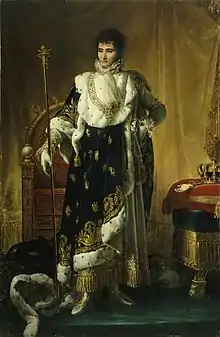 Portrait by François Gérard | |||||
| King of Westphalia | |||||
| Reign | 8 July 1807 – 26 October 1813 | ||||
| President of the Senate | |||||
| In office | 28 January 1852 – 30 November 1852 | ||||
| Predecessor | Étienne-Denis Pasquier (Chamber of Peers) | ||||
| Successor | Raymond-Theodore Troplong | ||||
| Born | 15 November 1784 Ajaccio, Corsica, Kingdom of France | ||||
| Died | 24 June 1860 (aged 75) Vilgénis, Seine-et-Oise, France | ||||
| Burial | |||||
| Spouse | |||||
| Issue |
| ||||
| |||||
| House | Bonaparte | ||||
| Father | Carlo Buonaparte | ||||
| Mother | Letizia Ramolino | ||||
| Religion | Roman Catholicism | ||||
| Signature | |||||
From 1816 onward, he bore the title of Prince of Montfort.[2] After 1848, when his nephew, Louis Napoleon, became President of the French Second Republic, he served in several official roles, including Marshal of France from 1850 onward, and President of the Senate in 1852.[3] He was the only one of Napoleon’s siblings who lived long enough to see the Bonaparte restoration
Early life
Jérôme was born in Ajaccio, Corsica, the eighth and last surviving child (and fifth surviving son) of Carlo Buonaparte and his wife, Letizia Ramolino. He was a younger brother of his siblings: Joseph Bonaparte, Napoleon Bonaparte, Lucien Bonaparte, Elisa Bonaparte, Louis Bonaparte, Pauline Bonaparte, and Caroline Bonaparte.

He studied at the Catholic College of Juilly and Lay College at the Irish College in Paris,[4] and then served with the French Navy before going to the United States. On Christmas Eve, 24 December 1803, nineteen-year-old Jérôme married Elizabeth "Betsy" Patterson (1785–1879), the eighteen-year-old daughter of a prosperous ship-owner and merchant, William Patterson, in Baltimore (then the third-largest city in America).
His elder brother Napoleon was unable to convince Pope Pius VII in Rome to annul the marriage, and so he annulled the marriage himself (by a French imperial decree, on 11 March 1805), as a matter of state. At the time, Jérôme was on his way to Europe with Elizabeth, who was pregnant. They landed in neutral Portugal, and Jérôme set off to Italy to persuade his brother to recognize the marriage. Elizabeth tried to land in Amsterdam, hoping to enter France so her baby would be born on French soil, but the Emperor barred the ship from entering the harbor. Elizabeth went to England instead. The child, Jérôme Napoléon Bonaparte (1805–1870), was born there.
After the child was born, the Emperor followed up his decree of divorce with Roman Catholic and later French state divorce proceedings. Jérôme submitted to the Emperor's demands, and Elizabeth returned to America with her son. Elizabeth was later declared divorced from Jérôme by a special decree and act of the Maryland General Assembly in 1815.
King of Westphalia
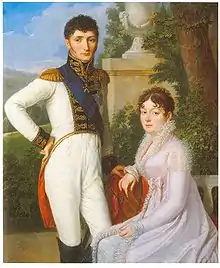
Napoleon made his brother King of Westphalia, a short-lived realm (1807–13) created by Napoleon from several states and principalities in northwestern Germany (in the former thousand-year old Holy Roman Empire, which was reorganized by Napoleon into the Confederation of the Rhine). After Napoleon's subsequent defeat, the Allies reorganized the German states into a German Confederation with Austrian leadership, largely overriding prior claim of lesser states.
The Napoleonic realm of Westphalia had its capital in Kassel (then: Cassel). Jérôme was married, as arranged by Napoleon before he was divorced with Elizabeth, to Princess Catharina of Württemberg, the daughter of Frederick I, King of Württemberg. A marriage to a German princess was intended to boost the dynastic standing of the young French king.
When Jérôme and Catharina arrived in Kassel, they found the palaces in a plundered state. As such, they placed orders for an array of stately furniture and expensive silverware with leading Parisian manufactures. Local artisans, eager for commissions, oriented themselves with these French models. The king also intended to refurbish his capital architecturally, and the court theatre ranks among the small number of projects realised. Jérôme had it designed by Leo von Klenze and constructed next to the summer residence, previously known as "Wilhelmshöhe", which was changed to "Napoleonshöhe". To emphasize his rank as a ruler, and pander to his own ego, Jérôme commissioned grandiose state portraits of himself and his spouse, Queen Catharina. Other paintings were to celebrate his military exploits, with many of France's most prominent painters taken into his employ.
As a model state, the Kingdom of Westphalia was expected by Napoleon to serve as an example for the other German states. It received the first constitution and parliament to be found on German soil (decades before other parliaments, legislatures, reichstags, bundesrats, etc. such as in Frankfurt in 1848). Jérôme imported the Empire style from Paris, bestowing the new state with a modern, representative appearance. The small kingdom thus received more attention since the famous Treaty of Westphalia, which ended the Thirty Years' War a hundred and sixty years earlier in 1648. Thanks to these efforts by King Jerome, Kassel celebrated an enormous cultural upturn.
However, Jérôme's expensive habits earned him the contempt of Napoleon. His court incurred expenses comparable to Napoleon's court (which oversaw a vastly larger and more important realm), and Napoleon refused to support Jérôme financially.[5]
In 1812, Jérôme was given command of a corps in the Grande Armée, marching towards Minsk. Insisting on travelling "in state", Napoleon reprimanded Jerome, ordering him to leave his court and luxurious trappings behind. After the Battle of Mir (1812), Jérome occupied Mir Castle. In pique at Napoleon's order, Jérôme returned with his entire court and train to Westphalia. After the defeat in Russia during the following winter, Jerome petitioned Napoleon to allow his wife to go to Paris, fearing the advance of the Allied armies. On the second attempt, Napoleon granted permission.
Jérôme briefly re-entered the army in 1813, when his kingdom was being threatened from the east by the advancing allied Prussian and Russian armies. He led a small force to challenge their invasion. Following a clash with an enemy detachment, he made camp with his army, hoping for reinforcements from the French army in the west. However, before reinforcements arrived, the main allied force captured the capital, Kassel. The Kingdom of Westphalia was declared dissolved, and Jérôme's kingship ended. He then fled to join his wife, the former queen, in France.
The Hundred Days
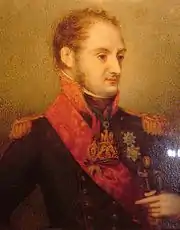

During the "Hundred Days", Napoleon placed Jérôme in command of the 6th Division of the II Corps under General Honoré Charles Reille. At Waterloo, Jérôme's division was to make an initial attack on Hougoumont. It is said that Napoleon wished to draw in the Duke of Wellington's reserves. Whatever the intent, Jérôme was allowed to enlarge the assault such that his division became completely engaged attempting to take Hougoumont to the exclusion of any other possible deployment, without significantly weakening Wellington's centre.
Later years
Although Catharina was aware of Jérôme's womanising and affairs, she remained true to her husband. They had two sons, Prince Jérôme Napoléon Charles Bonaparte (1814–1847) and Prince Napoléon Bonaparte (1822–1891), also known as "Prince Napoleon" or "Plon-Plon." Their second child was a daughter, Princess Mathilde Bonaparte, who was a prominent hostess during and after the Second French Empire of Napoleon III (1852–70).
After the dissolution of his kingdom, Jérôme was given the title of "Prince of Montfort" (French: prince de Montfort)[6] by his father-in-law, King Frederick I of Württemberg, in July 1816.[7] Previously, King Frederick had forced Jérôme and his wife to leave the country in 1814. During their exile, they visited the United States (his second time there). Jérôme later returned to France and joined Napoleon during an attempt to restore the Empire during the "Hundred Days".
Later, Jérôme moved to Italy, where he married his third wife, Giustina Pecori-Suárez. She was the widow of an Italian Marquess, Luigi Bartolini-Baldelli.
In 1848, his nephew, Prince Louis Napoleon, became President of the second French Republic. Jérôme was made Governor of Les Invalides in Paris, which was the burial place of Napoleon I. When Louis Napoleon became emperor as Napoleon III, Jérôme was recognized as the heir presumptive to the re-established imperial throne until the birth of Napoléon Eugène, Prince Imperial. Jérôme was named a Marshal of France in 1850, served as President of the Senate (the upper house in the French Republic's parliament, compared with the lower house of the National Assembly) in 1852, and received the title of "Prince Français".
Jérôme Bonaparte died on 24 June 1860, at Villegenis, France (today known as Massy in Essonne). He is buried in Les Invalides.
His grandson, Charles Joseph Bonaparte (son of Jerome "Bo" Napoleon Bonaparte, 1805–1870), served as United States Secretary of the Navy and United States Attorney General in President Theodore Roosevelt's administration, 1901-1909. In 1908, he established a Bureau of Investigation within the 38-year-old Department of Justice. The bureau grew under director J. Edgar Hoover and was renamed the Federal Bureau of Investigation (F.B.I) in 1935.
Another grandson was Jerome Napoleon Bonaparte II, (1829–1893). In the early 1850s, he graduated from the United States Military Academy at West Point, was commissioned an officer in the United States Army, and served with the Mounted Rifles in Texas on the American southwestern frontier. He eventually resigned his commission and joined the forces of his cousin, the Emperor Napoleon III in his second French Empire.
Among Jérôme Bonaparte's illegitimate children was Baroness Jenny von Gustedt, born as Jeromée Catharina Rabe von Pappenheim (1811–1890). She became the grandmother of the German Socialist and Feminist writer Lily Braun.
In fiction and popular culture
The 1923 German comedy film The Little Napoleon is loosely based around his life. He is played by Paul Heidemann.
In the Hornblower television series, he was portrayed by British actor David Birkin. The last episode (Duty) introduces Jérôme and Elizabeth ('Betsy'). Adrift in an open boat, they are picked up by Captain Hornblower's ship; Jérôme poses as a harmless Swiss citizen, but Hornblower identifies him. After many diplomatic manoeuvres, the British government decides that Jérôme is of no political importance after all, and he is allowed to return to France while Elizabeth is put aboard a passing American ship.
Jerome and Betsy's marriage is portrayed in the historical novel "The Ambitious Madame Bonaparte" by Ruth Hull Chatlien, published in 2013.
In the 1936 film Hearts Divided, Jerome was portrayed by Dick Powell. Elizabeth Patterson was played by Marion Davies, with Claude Rains as Napoleon.
Family
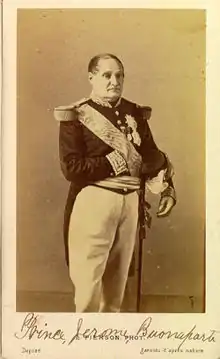
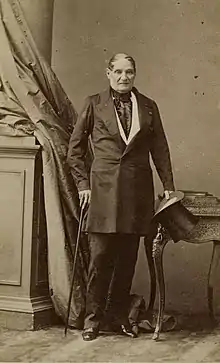
Descendents of Jérôme Bonaparte and Elizabeth Patterson
- Jérôme Napoléon Bonaparte (1805–1870)
- Jerome Napoleon Bonaparte II (1830–1893)
- Louise-Eugénie Bonaparte (1873–1923)
- Jerome Napoleon Charles Bonaparte (1878–1945)
- Charles Joseph Bonaparte (1851–1921)
- Jerome Napoleon Bonaparte II (1830–1893)
Descendents of Jérôme Bonaparte and Catharina of Württemberg
- Jérôme Napoléon Charles Bonaparte (1814–1847)
- Mathilde Bonaparte (1820–1904), married Anatole Demidoff, 1st Prince of San Donato
- Napoléon-Jérôme Bonaparte (1822–1891), married Princess Maria Clotilde of Savoy
- Napoléon Victor Bonaparte (1862–1926), married Princess Clémentine of Belgium
- Clotilde Bonaparte (1912–1996), married Serge de Witt
- Louis Bonaparte (1914–1997), married Alix de Foresta
- Charles Bonaparte (1950–), married Princess Béatrice of Bourbon-Two Sicilies, Jeanne-Françoise Valliccioni
- Caroline Napoléon Bonaparte (1980–)
- Jean-Christophe Napoléon Bonaparte (1986–)
- Sophie Cathérine Bonaparte (1992–)
- Catherine Bonaparte (1950–), married Marquis Nicola di San Germano, Jean Dualé
- Laura Bonaparte (1952–), married Jean-Claude Leconte
- Jérôme Xavier Bonaparte (1957–)
- Charles Bonaparte (1950–), married Princess Béatrice of Bourbon-Two Sicilies, Jeanne-Françoise Valliccioni
- Napoléon Louis Joseph Jérôme Bonaparte (1864–1932)
- Maria Letizia Bonaparte (1866–1926), married Amedeo, 1st Duke of Aosta
- Napoléon Victor Bonaparte (1862–1926), married Princess Clémentine of Belgium
Honours
| Styles of Jérôme I of Westphalia | |
|---|---|
_2.svg.png.webp) | |
| Reference style | His Majesty |
| Spoken style | Your Majesty |
.svg.png.webp) Second French Empire: Baton of Maréchal de France
Second French Empire: Baton of Maréchal de France.svg.png.webp) Second French Empire: Médaille militaire
Second French Empire: Médaille militaire.svg.png.webp) Second French Empire: Grand Croix of the Legion of Honour
Second French Empire: Grand Croix of the Legion of Honour.svg.png.webp) First French Empire: Grand Croix of the Legion of Honour
First French Empire: Grand Croix of the Legion of Honour.svg.png.webp) First French Empire: Grand Croix of the Order of the Iron Crown
First French Empire: Grand Croix of the Order of the Iron Crown.svg.png.webp) First French Empire: Grand Croix of the Order of the Reunion
First French Empire: Grand Croix of the Order of the Reunion Netherlands: Grand Croix of the Order of the Union
Netherlands: Grand Croix of the Order of the Union Westphalia: Grand Master and Grand Croix of the Order of the Crown of Westphalia
Westphalia: Grand Master and Grand Croix of the Order of the Crown of Westphalia.svg.png.webp) Belgium: Grand Cordon of the Order of Leopold, 9 June 1855[8]
Belgium: Grand Cordon of the Order of Leopold, 9 June 1855[8] Württemberg: Grand Cross of the Military Merit Order, 18 January 1807[9]
Württemberg: Grand Cross of the Military Merit Order, 18 January 1807[9] Württemberg: Grand Cross of the Order of the Württemberg Crown[10]
Württemberg: Grand Cross of the Order of the Württemberg Crown[10] Grand Duchy of Hesse: Grand Cross of the Ludwig Order, August 1810[11]
Grand Duchy of Hesse: Grand Cross of the Ludwig Order, August 1810[11].svg.png.webp) Kingdom of Saxony: Knight of the Order of the Rue Crown, 1807[12]
Kingdom of Saxony: Knight of the Order of the Rue Crown, 1807[12] Denmark: Knight of the Order of the Elephant, 22 March 1811[13]
Denmark: Knight of the Order of the Elephant, 22 March 1811[13].svg.png.webp) Kingdom of Sardinia: Knight of the Order of the Annunciation, 29 November 1855[14]
Kingdom of Sardinia: Knight of the Order of the Annunciation, 29 November 1855[14]
Ancestry
| Ancestors of Jérôme Bonaparte | |||||||||||||||||||||||||||||||||||||||||||||||||||||||||||||||||||||||||||||||||||||||||||||||||||||||||||||||||||||||||||||||||||||||||||||||||||||||||||||||||||||||||||||||||||||||||||||||||||||||||||||||||||||||||||||||||||||||||||||||||||||||||||||||||||||||||||||||||||||||||
|---|---|---|---|---|---|---|---|---|---|---|---|---|---|---|---|---|---|---|---|---|---|---|---|---|---|---|---|---|---|---|---|---|---|---|---|---|---|---|---|---|---|---|---|---|---|---|---|---|---|---|---|---|---|---|---|---|---|---|---|---|---|---|---|---|---|---|---|---|---|---|---|---|---|---|---|---|---|---|---|---|---|---|---|---|---|---|---|---|---|---|---|---|---|---|---|---|---|---|---|---|---|---|---|---|---|---|---|---|---|---|---|---|---|---|---|---|---|---|---|---|---|---|---|---|---|---|---|---|---|---|---|---|---|---|---|---|---|---|---|---|---|---|---|---|---|---|---|---|---|---|---|---|---|---|---|---|---|---|---|---|---|---|---|---|---|---|---|---|---|---|---|---|---|---|---|---|---|---|---|---|---|---|---|---|---|---|---|---|---|---|---|---|---|---|---|---|---|---|---|---|---|---|---|---|---|---|---|---|---|---|---|---|---|---|---|---|---|---|---|---|---|---|---|---|---|---|---|---|---|---|---|---|---|---|---|---|---|---|---|---|---|---|---|---|---|---|---|---|---|---|---|---|---|---|---|---|---|---|---|---|---|---|---|---|---|---|---|---|---|---|---|---|---|---|---|---|---|---|---|---|---|
| |||||||||||||||||||||||||||||||||||||||||||||||||||||||||||||||||||||||||||||||||||||||||||||||||||||||||||||||||||||||||||||||||||||||||||||||||||||||||||||||||||||||||||||||||||||||||||||||||||||||||||||||||||||||||||||||||||||||||||||||||||||||||||||||||||||||||||||||||||||||||
References
- Connelly, 1964.
- Gentleman's Magazine and Historical Review. London: Henry & Parker. 1860. p. 208.
- Taxile Delord (1869). Histoire du Second Empire (1848–1869) (in French). Paris: G. Baillière.
Jérôme Bonaparte second empire.
- IV Irish Links with Napoleon By Dr. Richard Hayes, Studies: An Irish Quarterly Review, Vol. 35, No. 137 (Mar., 1946), pp. 63-74 (12 pages), Messenger Publications.
- "La Grande Armée" by Georges Blond, translated by Marshall May, p. 303
- Grant, Donald (1966). The House of Bonaparte, 1640-1965. p. 10.
- Antoine-Vincent Arnault; Antoine Jay; Étienne de Jouy; Jacques Marquet de Norvins (1821). Biographie nouvelle des contemporains (in French). Paris: Librairie historique. p. 239.
- Ferdinand Veldekens (1858). Le livre d'or de l'ordre de Léopold et de la croix de fer. lelong. p. 187.
- Württemberg (1858). Königlich-Württembergisches Hof- und Staats-Handbuch: 1858. Guttenberg. pp. 55.
- Württemberg (1831). Königlich-Württembergisches Hof- und Staats-Handbuch: 1831. Guttenberg. p. 27.
- Hessen-Darmstadt (1854). Hof- und Staatshandbuch des Großherzogtums Hessen: für das Jahr ... 1854. Staatsverl. p. 6.
- Sachsen (1857). Staatshandbuch für den Freistaat Sachsen: 1857. Heinrich. p. 3.
- J ..... -H ..... -Fr ..... Berlien (1846). Der Elephanten-Orden und seine Ritter. Berling. pp. 132–134.
- Luigi Cibrario (1869). Notizia storica del nobilissimo ordine supremo della santissima Annunziata. Sunto degli statuti, catalogo dei cavalieri. Eredi Botta. p. 115.
Further reading
- Connelly, Owen. "Jerome Bonaparte, King of Westphalia," History Today ( Sep 1964) 14#9 pp 627–633.
External links
| Wikimedia Commons has media related to Jérôme Bonaparte. |
- Online Biography of Jérôme Bonaparte (in French)
- Online Biography of Jérôme Bonaparte (in German)
- König Lustik!? Jérôme Bonaparte and the Model State Kingdom of Westphalia. State Exhibition of Hesse 2008. Museum Fridericianum Kassel / Germany
- . Appletons' Cyclopædia of American Biography. 1900.
Jérôme Bonaparte Born: 15 November 1784 Died: 24 June 1860 | ||
| Regnal titles | ||
|---|---|---|
| New title | King of Westphalia 8 July 1807 – 26 October 1813 |
Kingdom dissolved |
| Titles in pretence | ||
| Kingdom dissolved | — TITULAR — King of Westphalia 26 October 1813 – 24 June 1860 Reason for succession failure: Kingdom dissolved in 1813 |
Succeeded by Napoléon-Jérôme |
| French royalty | ||
| Preceded by Robert, Duke of Chartres |
Heir to the French Throne as Heir presumptive 18 December 1852 – 16 March 1856 |
Succeeded by Louis Napoléon, Prince Imperial |
2.svg.png.webp)
.svg.png.webp)